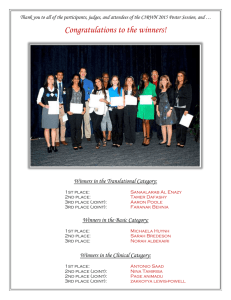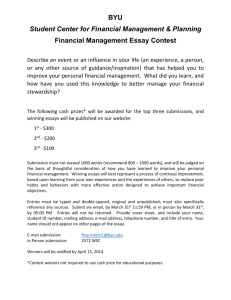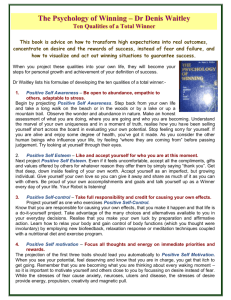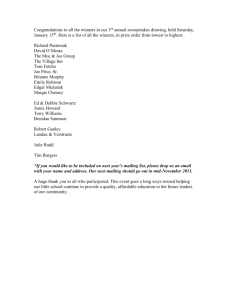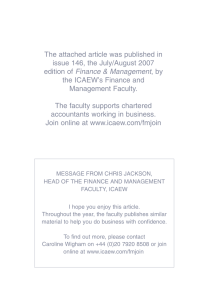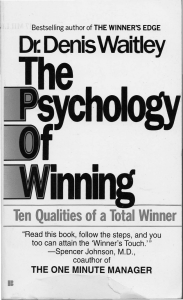A Formula For Sustained Success
advertisement
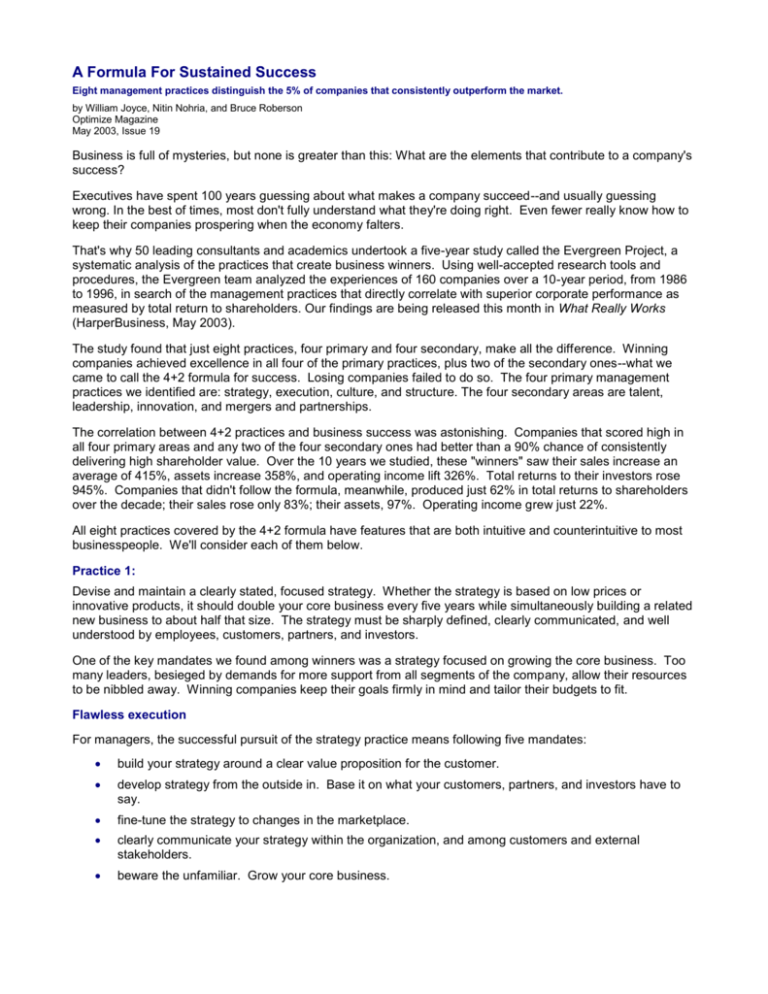
A Formula For Sustained Success Eight management practices distinguish the 5% of companies that consistently outperform the market. by William Joyce, Nitin Nohria, and Bruce Roberson Optimize Magazine May 2003, Issue 19 Business is full of mysteries, but none is greater than this: What are the elements that contribute to a company's success? Executives have spent 100 years guessing about what makes a company succeed--and usually guessing wrong. In the best of times, most don't fully understand what they're doing right. Even fewer really know how to keep their companies prospering when the economy falters. That's why 50 leading consultants and academics undertook a five-year study called the Evergreen Project, a systematic analysis of the practices that create business winners. Using well-accepted research tools and procedures, the Evergreen team analyzed the experiences of 160 companies over a 10-year period, from 1986 to 1996, in search of the management practices that directly correlate with superior corporate performance as measured by total return to shareholders. Our findings are being released this month in What Really Works (HarperBusiness, May 2003). The study found that just eight practices, four primary and four secondary, make all the difference. Winning companies achieved excellence in all four of the primary practices, plus two of the secondary ones--what we came to call the 4+2 formula for success. Losing companies failed to do so. The four primary management practices we identified are: strategy, execution, culture, and structure. The four secondary areas are talent, leadership, innovation, and mergers and partnerships. The correlation between 4+2 practices and business success was astonishing. Companies that scored high in all four primary areas and any two of the four secondary ones had better than a 90% chance of consistently delivering high shareholder value. Over the 10 years we studied, these "winners" saw their sales increase an average of 415%, assets increase 358%, and operating income lift 326%. Total returns to their investors rose 945%. Companies that didn't follow the formula, meanwhile, produced just 62% in total returns to shareholders over the decade; their sales rose only 83%; their assets, 97%. Operating income grew just 22%. All eight practices covered by the 4+2 formula have features that are both intuitive and counterintuitive to most businesspeople. We'll consider each of them below. Practice 1: Devise and maintain a clearly stated, focused strategy. Whether the strategy is based on low prices or innovative products, it should double your core business every five years while simultaneously building a related new business to about half that size. The strategy must be sharply defined, clearly communicated, and well understood by employees, customers, partners, and investors. One of the key mandates we found among winners was a strategy focused on growing the core business. Too many leaders, besieged by demands for more support from all segments of the company, allow their resources to be nibbled away. Winning companies keep their goals firmly in mind and tailor their budgets to fit. Flawless execution For managers, the successful pursuit of the strategy practice means following five mandates: build your strategy around a clear value proposition for the customer. develop strategy from the outside in. Base it on what your customers, partners, and investors have to say. fine-tune the strategy to changes in the marketplace. clearly communicate your strategy within the organization, and among customers and external stakeholders. beware the unfamiliar. Grow your core business. Practice 2: Develop and maintain flawless operational execution. If you can't always delight your customers, you must at least never disappoint them. There's no question that poor quality hurts. Companies are safe as long as they remain in the top third of the perceived quality rankings in their industry, and can never afford to slip into the bottom half. Winners constantly slash operational costs while increasing productivity by 6% to 7% every year. Superior execution can be achieved only through intense and continuing study and effort. Managers also must be willing to ignore some conventional wisdom. We found no relationship between outsourcing and financial performance, for example; nor did success hinge on CRM, ERP, or supply-chain management systems. While these applications and services are important elements of overall strategy, they don't correlate directly to the bottom line. Duke Power, for example, aggressively used IT to improve execution on its strategy of delivering significantly enhanced power quality and service levels to customers in both its regulated and unregulated businesses. Kohl's stores also are very effective in execution, so much so that they can offer department-store products at the same cost as lower-quality goods sold in discount chains. This unique strategy, shared within the company and embedded in its strong culture, lets it grow at a rate far exceeding its competitors. We found three mandates for the execution practice: Deliver products and services that consistently meet customers' expectations. Empower the front lines to respond to customer needs. And constantly strive to improve productivity and eliminate all forms of excess and waste. Practice 3: Develop and maintain a performance-oriented culture. Among our more intriguing findings was the emergence of culture as one of the four primary practices. Some quarters of the business world are just beginning to take culture seriously. Yet the study clearly showed that companies become winners when everyone in the organization performs at the highest level. Corporate-culture advocates sometimes argue that if you can make the work fun, all else will follow. But our results suggest that winning corporate cultures put fun second to high performance. First they do the job well; then they celebrate. We also found that too many companies fool themselves into believing they're doing well whenever their financial results beat those of the previous year. But winners know that a year-to-year comparison is an insufficient measure. The only meaningful way to define progress is by comparing your performance with that of your competitors. True performance-based cultures go a step further: They aim to surpass top-ranked companies in every industry. The four mandates for winning corporate cultures, then, are: Inspire all to do their best. Establish and abide by clear company values. Reward achievement with praise and pay, but keep raising the performance bar. Create a work environment that's challenging, satisfying, and fun. Practice 4: Maintain a fast, flexible, flat organization. There's just one kind of structure that really counts: one that reduces bureaucracy and simplifies work. Procedures and protocols--what bureaucracy is, after all—are absolutely necessary to keep large organizations functioning smoothly. But an excess of them puts roadblocks in the way of progress and dampens employees' enthusiasm and energy. Winners trim away every vestige of bureaucracy. USAA, the insurance company, calls this "painting the bridge." When maintenance experts finish painting one side of a bridge, they know it's time to start again on the other side. Similarly, when USAA finishes eliminating bureaucratic obstacles to its core processes, it begins the search anew. The mandates for winning corporate structures are: Eliminate redundant organizational layers and bureaucratic structures and behaviors. Promote cooperation and information exchange across the company. Keep your best people close to the action and your front-line stars in place. Beyond the four major management practices that lead to success are four secondary ones. Oddly, we found that it doesn't matter which two practices a company chooses to pursue. Any pair, in combination with the four major practices, will suffice. The secondary practices are: 1. Hold onto talented employees and find more. The most important indicator of the depth and quality of your talent is whether you can grow your own stars from within instead of buying talented outsiders in every crisis. Winners like Citigroup, General Electric, and Procter & Gamble have mastered the deep bench by providing broad educational and training opportunities. Winners don't completely shy away from pursuing talent from outside, though. Their talent-rich environment helps attract even more good people.\ 2. Winning companies promote from within whenever possible, create top-of-the-line training, and design jobs that challenge their best performers. And their leaders get personally involved in winning the war for talent. 3. Make industry-transforming innovations. One might expect that winners would excel at innovation—but only a bare majority did. Companies that excel keep their eye on the big opportunity—the totally new and disruptive product or technological breakthrough with potential to transform their industry. They don't limit innovation to product lines, either; they understand that applying new and old technologies to internal business processes can yield as big an edge on the competition. Sony, for example, keeps its focus on its core business of consumer electronics, but stays at the leading edge of the innovation curve. It constantly introduces breakthrough products and new models, even if they hurt sales of existing ones. 4. Make growth happen with mergers and partnerships. Internally generated growth is essential, but it's not usually enough. Best practices in mergers and acquisitions include buying new businesses that leverage your existing customer relationships and complement your strengths, and developing a systematic capability to identify, screen, and close deals. Relatively small deals—less than 20% of a company's own size—done on a consistent basis (two or three every year) are better than large, occasional deals. 5. Keep leaders and directors committed to the business. Great chief executives communicate their vision so convincingly that others adopt it, and they have great integrity in word and action. When confronted by moral dilemmas, they don't hesitate to resolve them fairly and quickly. Good CEOs are picked by good boards. Only two characteristics really matter: that board members truly understand the business and are passionately committed to it. Winning companies make sure board members have a substantial stake in their success and closely link executive pay to performance. The scary fact is that less than 5% of all the publicly traded companies in our study maintained a total return to shareholders greater than their industry peers for more than 10 years. Joining this elite club means running fullspeed on six tracks at once. Still, we see the Evergreen study as offering hope. In the hurly-burly of business competition, the 4+2 formula offers solid directions for success. William Joyce is a professor of strategy at Amos Tuck School of Business at Dartmouth College; Nitin Nohria is chairman of the Organizational Behavior department at Harvard Business School; Bruce Roberson is a senior manager at Safety-Kleen. They are authors of What Really Works: The 4+2 Formula for Sustained Business Success (HarperBusiness, May 2003).
